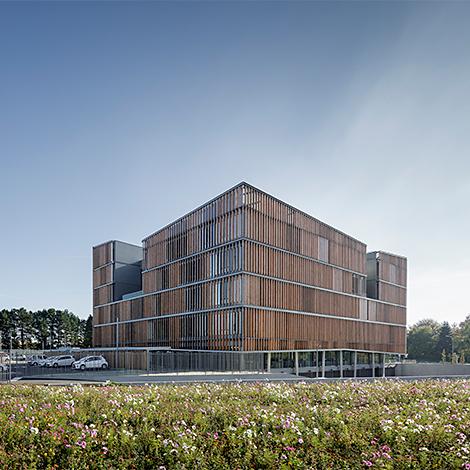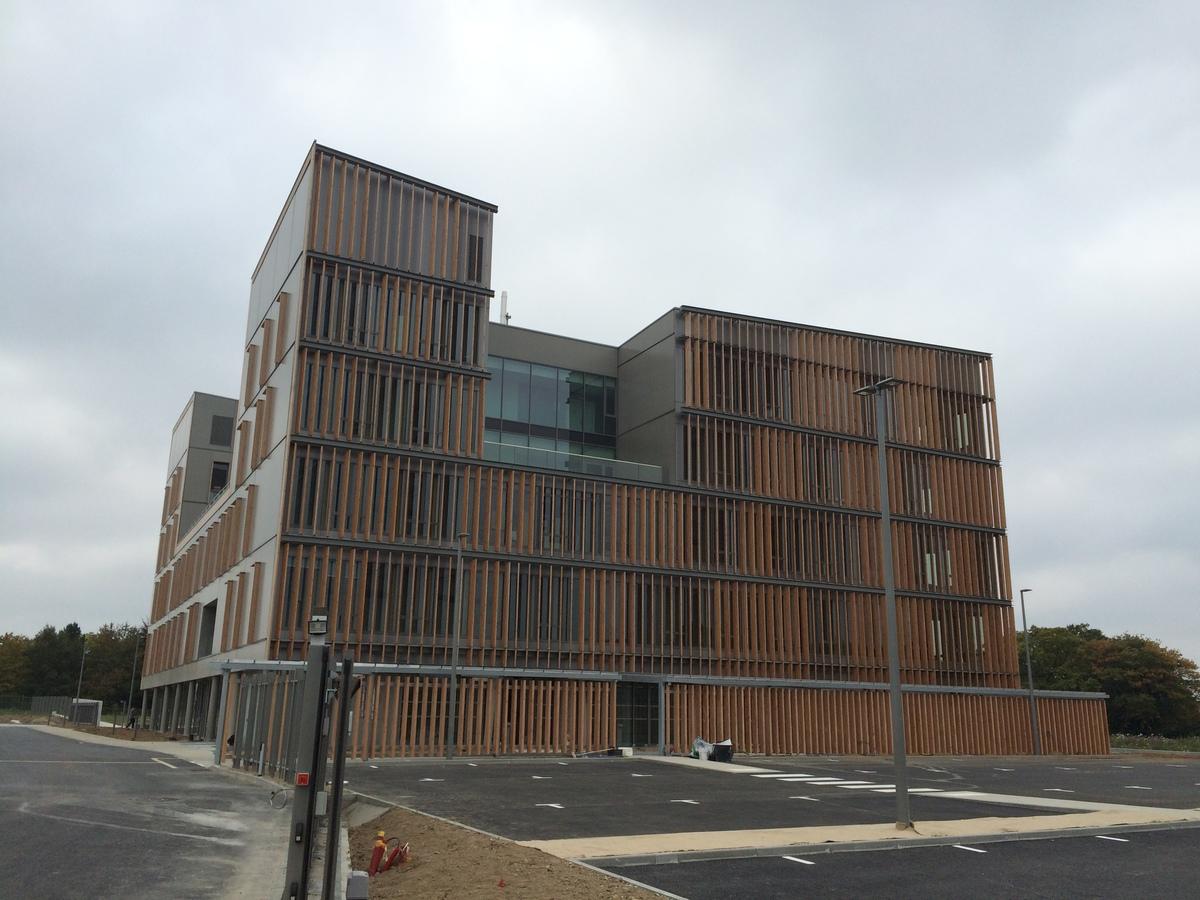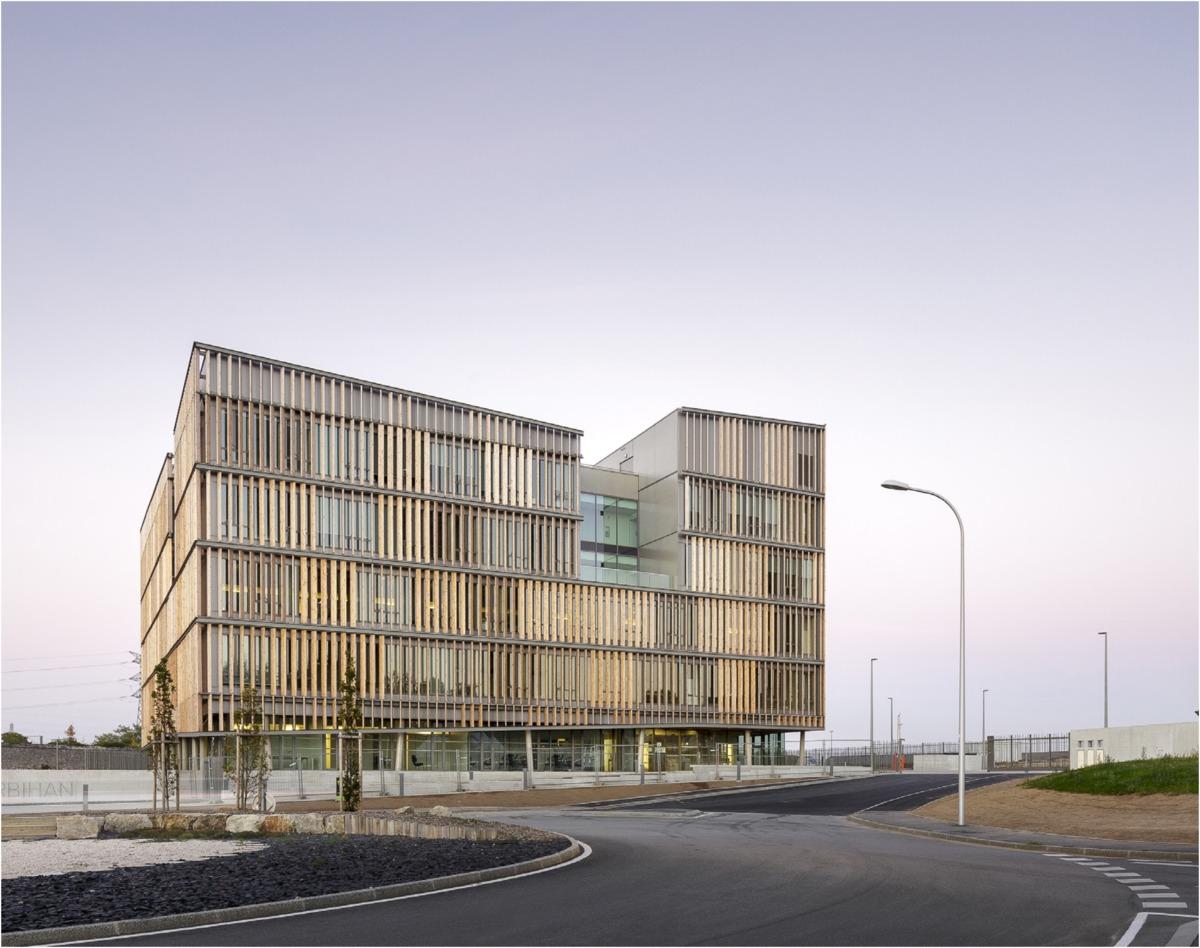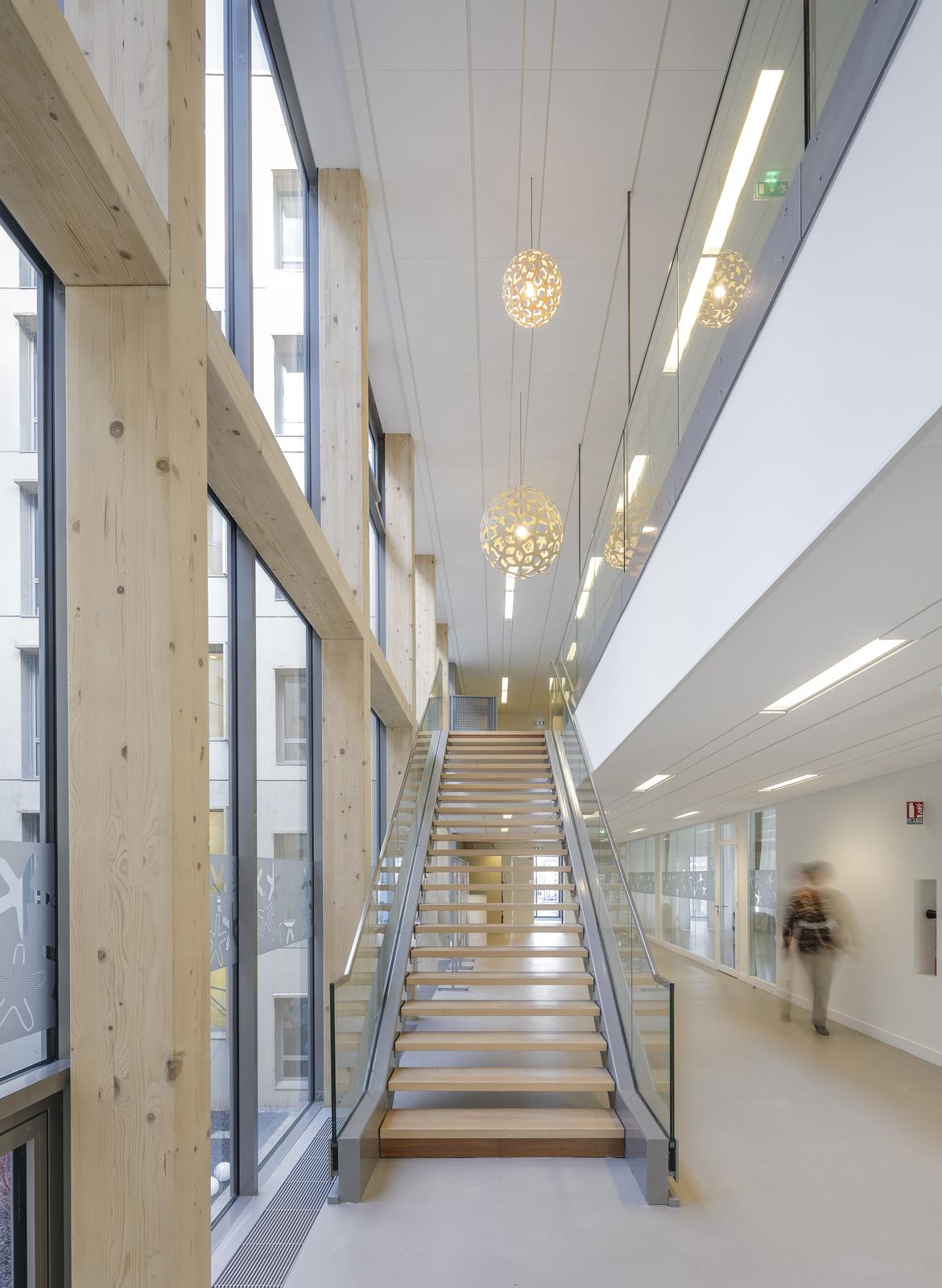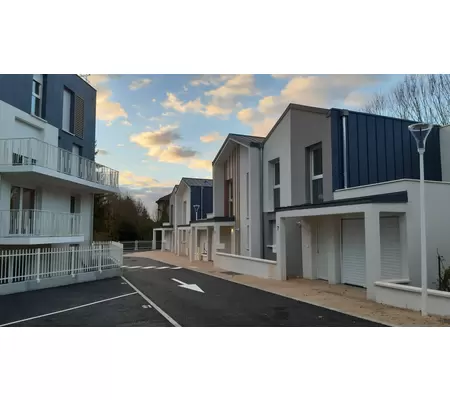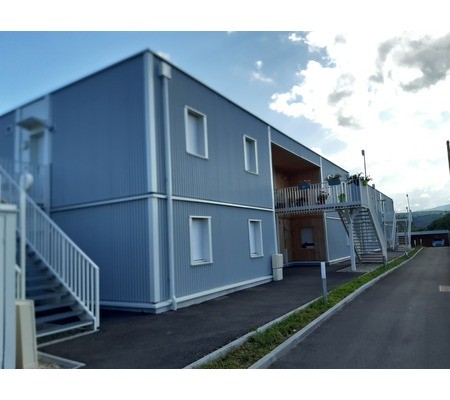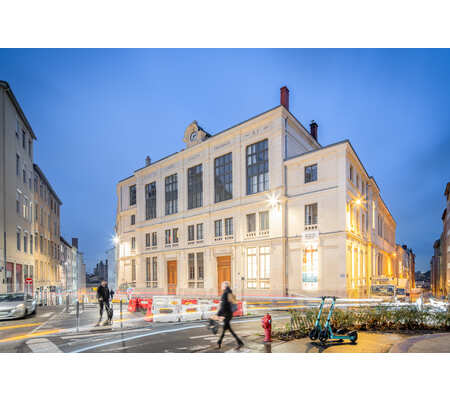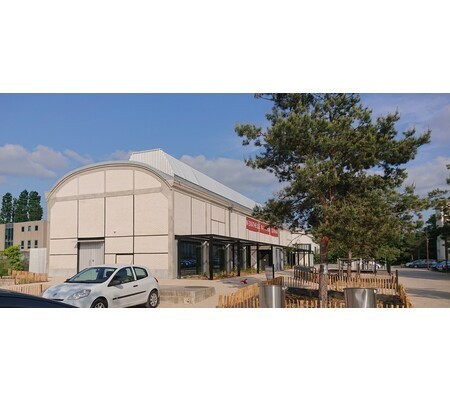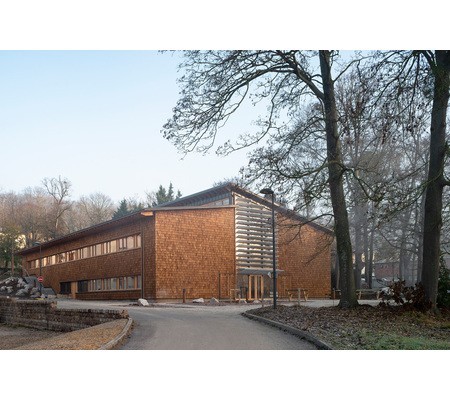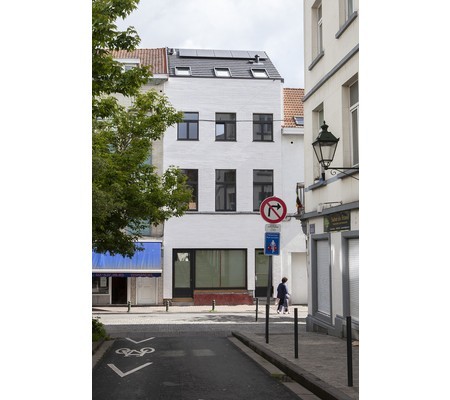Departmental Direction of territories and the sea of Morbihan-Vannes
Last modified by the author on 22/05/2018 - 18:07
New Construction
- Building Type : Office building < 28m
- Construction Year : 2015
- Delivery year : 2016
- Address 1 - street : 56000 VANNES, France
- Climate zone : [Cfb] Marine Mild Winter, warm summer, no dry season.
- Net Floor Area : 6 500 m2
- Construction/refurbishment cost : 9 700 000 €
- Number of Work station : 200 Work station
- Cost/m2 : 1492.31 €/m2
-
Primary energy need
47.6 kWhep/m2.an
(Calculation method : RT 2012 )
Identity card of the building:
Project management: Prefecture of Morbihan
Architect: AIA Lorient
Engineering: AIA Engineering + AIA Studio Wood + AIA Studio Environment
Level: R + 4 with LT in R + 5 (+1 SS level) - Max Height: 21,5m
Floor area: 6500m² SHON including 4500m² mixed wood-concrete floor (+ 900m² roof)
Facade surface: Facade Mixed Wood-concrete 1700m² - Wood structure 1350m² - MOB 200m²
Wood volume: 1200m3 including BLC: primary structure beam post 120m3 - Floor joists 390m3 - Facade (FMB + Str Wood) 110m3 - Sunbreaker 50m3
Cost: Total 9.7M € HT
MOE Mission: Design + EXE MOP MOE
As a promontory on the heights of Vannes, the arrival of the building of the DDTM on the site "The Troadec" allows to start the momentum of renewal of the district . The project integrates the green flow from the pond to the Duke by extending pedestrian paths and landscaping. The layout of a forecourt, as future connecting element of the administrative city contributes to the spatial continuity of these soft movements. The slender volumetry of the project creates an urban landmark in the landscape from the railway and the road, symbolizing the transformation of this geographical area of the city. The wooden envelope creates a variation of appearances throughout the year, depending on the inclination of its vertical sunshades. The concrete base is born at the foot of the landscaped park and extends east of the site to become the forecourt. The fully glazed facade of the upper ground floor raises the upper volume, and accentuates its signal effect in this urban environment. The outdoor terraces, scattered over all levels, are all possible extensions. Along the North / South crossing hall, all services are wrapped around a central landscaped patio and develop on 6 levels. The extension of the hall allows temporary exhibitions and places of exchange and conviviality.
The design of this high-performance and innovative office building respects several rules of the passive and bioclimatic construction: compactness of volumes, reduction to the minimum of the lossy surfaces, limitation of the thermal bridges thanks to thermal insulation by the outside, optimization of the lighting natural in offices, natural night ventilation, fixed or mobile solar protection depending on orientation, and constructive wood / concrete solutions. On masonry foundations and ground floor rise glued laminated spruce beams, supporting mixed floors with apparent poplar sub-surface. An innovative and patented process has been designed and implemented on the facade that combines the flexibility of a wood frame with the mineral finish of a prefabricated concrete wall.
Sustainable development approach of the project owner
For this building, the project owner wanted it to be an urban landmark with a strong environmental image. Here are the main objectives that were set by the project owner: THEME 1: Well-being - Acoustic environment quality - Natural lightning - Artificial lightning - Electromagnetic fields - Air pollution - Ventilation THEME 2: Energy - Bioclimatic - Energy performance objectives - Bilan on the building's life cycle THEME 3: Transport -Parket layout -Smooth movements -Motorways
Architectural description
As a promontory on the highs of Vannes, the arrival of the building of the DDTM on the site "The Troadec" allows to start the momentum of renewal of the district. The project integrates the couléeverte from the pond to the Duke by the extension of pedestrian paths and the landscaping of landscaped areas. The layout of a square contributes to the spatial continuity of these soft movements. The slender volumetry of the project creates an urban landmark in the landscape. The wood casing creates a variation of appearances throughout the year, depending on the inclination of vertical sun shades. The fully glazed facade of the upper ground floor releases the upper volume, and accentuates its signal effect. The outer terraces are as many spaces of possible extensions. Along the north / south corridor, all the services are wrapped around a central patio.
Contractor
Construction Manager
Stakeholders
Company
CRUARD
http://www.cruard-charpente.com/Implementation of the principle of the FMB® Façade
Energy consumption
- 47,60 kWhep/m2.an
- 77,00 kWhep/m2.an
Envelope performance
- 0,30 W.m-2.K-1
- 0,50
- 0,90
Systems
- Radiant ceiling
- Wood boiler
- Individual electric boiler
- No cooling system
- Free-cooling
- Single flow
- Double flow heat exchanger
- Solar photovoltaic
- Wood boiler
- 36,00 %
Urban environment
- 12 409,00 m2
- 13,00 %
- 6 109,00
Product
Mixed Façade Wood Concrete FMB®
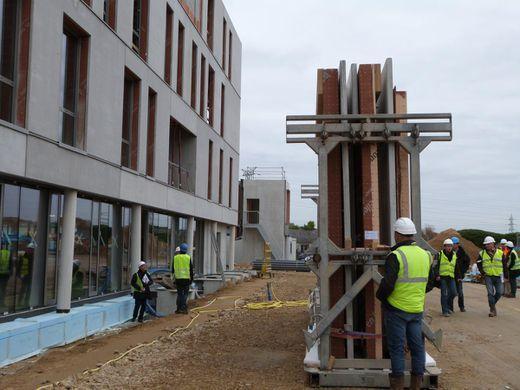
Cruard Charpente et Jousselin
http://www.jousselin.fr/Gros œuvre / Structure, maçonnerie, façade
The FMB facade is an innovative facade to obtain the structural flexibility of the wood and the mineral finish of the concrete. It is constituted
a load-bearing wooden frame and an outer concrete skin. Its assembly is mechanical and realized via SBB connectors.
This system ensures the structural homogeneity of the building while respecting the richness of the architectural bias. Insulating, mixed, lighter than a prefabricated concrete facade, the FMB facade (in structure carried or carrier) allows a saving of weight and material on the secondary supporting structure (beams, poles or foundations). It also incorporates reinforced insulation.
The mixed walls are prefabricated, their implementation, by simple mechanical assembly is fast (no scaffolding or props).
Its composition avoids thermal bridges, especially to connections on floors and slats.
The modules composing the FMB facade are of a non-limiting length and a floor height (max. 4.00m).
This facade is the subject of an ATEX type B for this project
Construction and exploitation costs
- 1 230 000 €
- 16 000 000 €
Water management
- 709,00 m3
- 838,00 m3
Indoor Air quality
Comfort
- North-North East facade: external solar protection in fixed vertical wood slats, supplemented by external blinds for total concealment and interior blinds for protection against glare.
- East-South-East facade: L-shaped sun shading caps, supplemented by external blinds for total concealment and interior blinds for protection against glare.
- south-south west facade: external solar protection in movable vertical wood slats and interior blinds for protection against glare.
- west-north west facade: external solar protection in movable vertical wood slats and interior blinds for protection against glare.
- In the East: interior blinds + participation of vegetation nearby,
- South: interior blinds + overhang + wood blades in skirt,
- In the West: interior blinds + shutters + wood blades in skirt,
- North: interior blinds + wood blades in skirt.
GHG emissions
- 15,00 année(s)
- 136,00 KgCO2 /m2
Life Cycle Analysis
- 1 040,00 kWhEP
Reasons for participating in the competition(s)
The project's assets for the Low Carbon category are:
- A level of energy performance confirmed by an energy consumption of 47.6 kWh / m² (SHON RT) / year. This performance is ensured in particular by the implementation of a real passive and bioclimatic design of the building (compactness, adapted solar protection, optimization of natural lighting, natural nocturnal ventilation of offices ...) associated with efficient equipment including 2 wood pellet boilers (2x110 kW) and radiant ceilings for heating.
- A volume of biobased materials including wood used in the consequent project: 148 dm3 / m² thus this project contributes to the reduction of the carbon footprint. Indeed, the project uses the innovative and patented facade process which is the Mixed Wood Concrete Façade FMB which consists of a wood frame and a prefabricated concrete siding (to reduce the carbon impact and the time of implementation on site) subject to an ATEX (type B) for this project. The FMB façade provides the structural flexibility of the wood and the mineral finish of the concrete. Its assembly is mechanical and realized via SBB connectors. In addition, materials such as hemp or algae-based paints have been used on this project, always in this perspective of low carbon footprint.
Building candidate in the category

Bas Carbone

Coup de Cœur des Internautes






